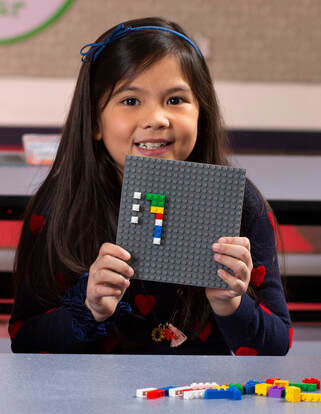 I recently had a customer tell me that her son didn’t understand the idea of factors until she tried Brick Math. When he saw the concept of factors made real with LEGO bricks, she said, he knew what they were! It’s exciting to hear when students finally “get it” because modeling with bricks makes all the difference for them. I started to think about that lesson on factors, and I realized it is the perfect way to demonstrate the power of Brick Math as a learning system. Here’s why Brick Math works so well to teach elementary math: it’s tactile (kids touch the bricks and build the models themselves), it’s visual (kids can see exactly what the numbers in a math problem represent), and it’s conceptual (kids understand the underlying idea behind the math when they discover it for themselves in a guided program). Let me show you how Brick Math works with that lesson on factors: This lesson models all the factors of 16 and demonstrates perfectly the meaning of “factor." Like all Brick Math lessons, it starts with some basic bricks and a baseplate to build on. Begin by placing one brick that has 16 studs on the baseplate (studs are the bumps on LEGO bricks). This can be a 2x8 brick or a 1x16 brick.The model shows 1 brick with 16 studs, so the multiplication fact shown is 1 x 16 = 16. 16 and 1 are factors of 16.  Next, take two bricks that each have 8 studs and place them next to the brick that’s already on the baseplate. It’s best if those two bricks are two different colors. You’ll use either two 2x4 bricks or two 1x8 bricks. Now the model shows 2 (bricks) x 8 (studs) = 16, and that 2 and 8 are also factors of 16. Now, here’s where the Brick Math program really becomes a powerful learning tool. For the next step, ask the student, “Are there 3 bricks that are all the same size that you can use to build the next row?” Let your students try with different bricks. They will demonstrate to themselves that there are none, so 3 can’t be a factor of 16. It’s so important that students discover for themselves while they are learning. That’s what helps them internalize what the math is all about. When they move on to looking for 4 bricks, they’ll find that four 2x2 bricks or 1x4 bricks do the trick. Now, they have 4 (bricks) x 4 (studs) = 16, so 4 is another factor of 16.  Have them look again for 5, 6, and 7 bricks that work in the model. They’ll quickly figure out that none of those numbers are factors of 16. They’ll move on to modeling eight 1x2 bricks, with the multiplication fact of 8 x 2 = 16. Finally, they can add sixteen 1x1 bricks to the model to complete all the factors with the multiplication fact of 16 x 1 = 16. When you look at the final model and count the number of bricks, the final model clearly shows the factors of 16: 1, 2, 4, 8, and 16. Dr. Shirley Disseler, developer of the Brick Math method, demonstrates this same lesson in the video below.  The concept of factors is key to learning multiplication, division, and fractions, so it’s in all three of the Brick Math books on those subjects: Multiplication, Division, and Basic Fractions. And it (almost) goes without saying: students have fun while they learn! If you teach math or have a student at home who is learning math, check brickmath.com. The website includes videos for both teacher training and direct instruction of students. You can learn more about how Brick Math improves student math test scores and hear what people who are using Brick Math have to say about the program.
Brick Math is a K-6 math curriculum that uses LEGO® bricks to model 11 different math subjects: Counting, Addition, Subtraction, Multiplication, Division, Basic Fractions, Basic Measurement, Fraction Multiplication, Fraction Division, Advanced Measurement and Geometry, and Decimals. It works well for math intervention, for enrichment, and as a whole-school program. Materials are simple and need not be shared between students. It adapts easily to online instruction. Contact us with any questions.
0 Comments
Your comment will be posted after it is approved.
Leave a Reply. |
Categories
All
Archives
July 2024
|


